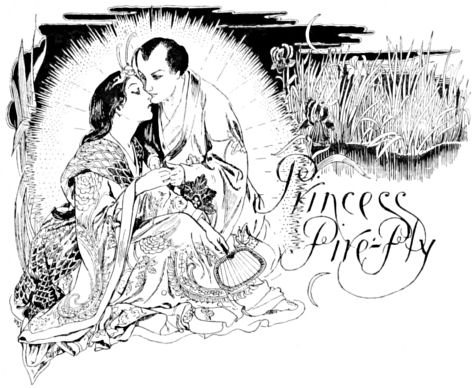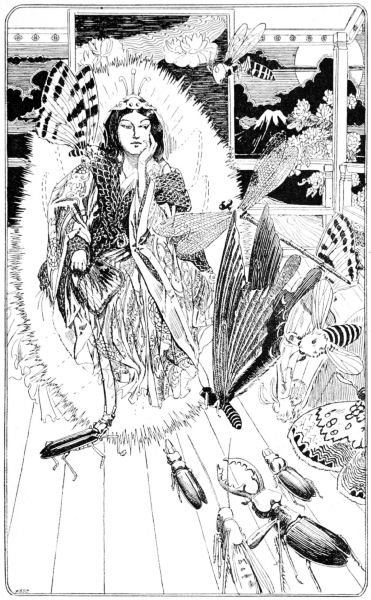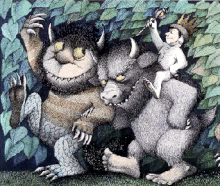 |
| Firefly Catching, by Mizuno Toshikata, 1891 |
This weekend is the start of a prolonged Fourth of July celebration. In some places fireworks are returning. At the same time dry conditions and smoke from the widespread Canadian wildfires make fireworks unwise in many other locations. Either way, nature is trying to bring us the unpredictable fireworks of the firefly. Look outside when it's dark and enjoy the display of Lightning Bugs or Fireflies. They are believed to be declining. At one point their gathering for scientific study and also pesticide spraying made me believe it, too, but I live in a semi-rural area and now think they may be returning. Over the centuries fireflies have fascinated people. The Japanese legend has been translated many times. I found four stories of the same legend in early Twentieth Century anthologies, but my favorite retelling was in The Turquoise Story Book, an anthology of summer stories by the Skinner sisters, Ada and Eleanor, which I've credited here before. In their table of contents they credit the retelling to Frank Rinder. A bit of further searching finds he was both an artist and a writer with his longer, but still poetic version of the story in his anthology, Old-World Japan; Legends of the Land of the Gods. Surprisingly he chose artist T.H. Robinson to illustrate the book, but Rinder was also "
colloquially called the Maybug, Maybeetle, or doodlebug, is a species of scarab beetle."
Princess Fire-Fly
DEEP in the pinky petals of a lotus bloom that grew in the castle moats of Fukui, in Echizen, lived Hi-O, the King of the Fire-Flies. In this beautiful flower his daughter, the Princess Hotaru, passed her childhood exploring every shady nook and fragrant corner of the bell-like palace, listening to the buzz of life around, and peeping over the edge of the petals at the wonderful world which lay mysteriously beyond. Hotaru-Himé had few youthful companions, but, as she daily bade her father farewell, she dreamed of the time when she, too, would fly abroad, and her brilliant light would attract universal admiration.
Gradually, a beautiful sheen o’erspread her body; night by night it became brighter, until at last her home, in the hours of darkness, was as a globe of coral wherein shone a lamp of gold. So glorious was her light that the stars paled before it, and the bright sickle moon withdrew behind a cloud from jealousy.
Himé was now allowed to fly from her home, to loiter among the pleasant rice fields, and to explore the indigo meadows which lay far off on the horizon. She had no lack of friends and would-be lovers; thousands of insects, attracted by her magic light, came and offered their homage, but Himé never forgot that she was of royal blood, and, while she haughtily thanked her many suitors, none found a way into her heart.
One evening the Princess, seated on a throne formed by the heart of the lotus, held her court. Soon the faint roseate petals of the flower were thronged with a host of ardent lovers. But the Princess whispered to herself, “Only he who loves me more than life shall call me bride.”
The golden beetle laid his fortunes at her feet, the cockchafer wooed her in passionate words, the dragon-fly proudly proffered his hand, and the hawk-moth humbly, yet persistently, addressed her. Countless other insects gained audience, but her answer was ever the same, “Go, and bring me fire, and I will be your bride.”
One by one they took wing, enraptured by the hope of success, and unconscious that they were all bent on the self-same errand. The hawk-moth entered the Buddhist Temple and circled round and round the tall wax lights, until, in an ecstasy of love, he flew into the flame, exclaiming, “Now to win the Princess or meet my death!” His poor singed body fell heavily to the ground. The beetle watched intently, for a moment or two, the log fire crackling on the hearth, and then, regardless of his fate, boldly caught at a tongue of flame he hoped to carry to Himé—but his end was that of the hawk-moth. The dragon-fly, notwithstanding his sunlit splendours, could not fulfil the bidding of the Lady of the Lotus Bloom; he also fell a prey to her imperious command. Other lovers there were who tried to steal from the diamond his heart of fire, who winged their way to the summit of Fukui, or sped to the depths of the valleys in search of the talisman that was to make Himé their bride. The sun rose in morning splendour over untold numbers of dead bodies, which alone remained to tell of the great devotion that had inspired the lovers of Princess Hotaru.
Now tidings came to Hi-Maro, a Prince of the Fire-Flies living hard by, that the Princess Hotaru was exceedingly beautiful; whereupon he flew swiftly to her home among the lotus flowers. Even as, with a flood of golden light, he entered, the charms of Himé were not dimmed. One look passed between the youth and the maiden, and then each felt that a great love filled their hearts. Hi-Maro wooed and wed, and for many years lived happily with Hotaru-Himé in the castle moats of Fukui.
Centuries have passed since Hi-Maro won his bride, and still the dazzling fire-fly Princesses send their insect lovers in search of fire.
****
As other insects fly into your fires or lights and you see the fireflies winking on and off, I hope you will remember this legend...and also watch out for the demands of beautiful princesses.
**************************
This is part of a series of postings of stories under the category, "Keeping the Public in Public Domain." The idea behind Public Domain was to preserve our cultural heritage after the authors and their immediate heirs were compensated. I feel strongly current copyright law delays this intent on works of the 20th century. My own library of folklore includes so many books within the Public Domain I decided to share stories from them. I hope you enjoy discovering new stories.
At the same time, my own involvement in storytelling regularly creates projects requiring research as part of my sharing stories with an audience. Whenever that research needs to be shown here, the publishing of Public Domain stories will not occur that week. This is a return to my regular posting of a research project here. (Don't worry, this isn't dry research, my research is always geared towards future storytelling to an audience.) Response has convinced me that "Keeping the Public in Public Domain" should continue along with my other postings as often as I can manage it.
Other Public Domain story resources I recommend-
There are many online resources for Public Domain stories, maybe none for folklore is as ambitious as fellow storyteller, Yoel Perez's database, Yashpeh, the International Folktales Collection. I have long recommended it and continue to do so. He has loaded Stith Thompson's Motif Index into his server as a database so you can search the whole 6 volumes for whatever word or expression you like by pressing one key. http://folkmasa.org/motiv/motif.htm
You may have noticed I'm no longer certain Dr. Perez has the largest database, although his offering the Motif Index certainly qualifies for those of us seeking specific types of stories. There's another site, FairyTalez claiming to be the largest, with "over 2000 fairy tales, folktales, and fables" and they are "fully optimized for phones, tablets, and PCs", free and presented without ads.
Between those two sites, there is much for story-lovers, but as they say in infomercials, "Wait, there's more!"








.jpg)
.jpg)
.jpg)

.jpg)



.jpg)
.png)


.jpg)
 The cedar is Lebanon's national emblem and on the national flag. May it replace the deserts.
The cedar is Lebanon's national emblem and on the national flag. May it replace the deserts.